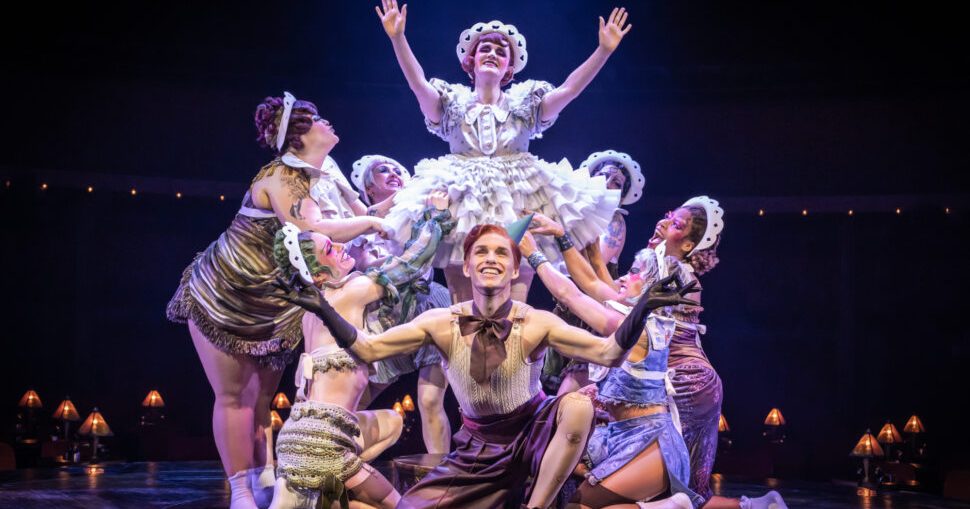
The timing feels very right for a revival of John Kander, Fred Ebb and Joe Masteroff’s seminal musical Cabaret. It’s only been 10 years since the last Broadway revival of the show but seems incredibly necessary right now to get people talking about how easy it is to ignore danger until it’s too late.
It also feels very timely to have a production of Cabaret directed by a woman, especially as the choices Sally Bowles makes throughout the show become increasingly controversial. Since Christopher Isherwood first created the character of Sally Bowles, she has been interpreted by men, from John Van Druten to John Kander, Fred Ebb, Joe Masteroff, Hal Prince and Bob Fosse. We’re long overdue for a new interpretation of the character under a woman’s direction.
And one could be optimistic walking into The Kit Kat Club at the August Wilson Theater. The creative team did an amazing job turning the theater into a maze of corridors and performance spaces and bars where everything seems both fun and exciting and just sketchy and chaotic enough to keep everyone on their toes. The hour-long pre-show is a great opportunity to watch dancers and musicians perform and enjoy the energy. The renovation to the main auditorium is gorgeous. The stage is now a fairly small platform in the round, surrounded by seats on the ground level and a balcony above. And it really looks perfect.Tom Scutt did an amazing job with the set.
But then the show begins, and so do the problems. Because the energy is already high from that pre-show, and Willkommen is a high-energy opening number, it starts to feel like too much right off the bat. And this seems to be how Frecknall has directed the show—too much and over the top. There are very few moments for the audience to catch its collective breath, and it gets exhausting. It also means that the moments that should be big have nowhere to grow. When Gayle Rankin makes her entrance as Sally for Don’t Tell Mama, she is in a baby costume and wails “Mama!” like an infant. That’s how the song starts. It’s difficult to build from that.
And that’s the biggest problem with this production—the style overwhelms the substance and the emotions in the story rarely get to build or shine. By the time everything reaches a crisis point, we’re overwhelmed and it’s hard to feel for the characters.
Rankin was a wonderful Fraulein Kost 10 years ago but her Sally is so constantly histrionic that it’s very hard to get a glimpse of what’s under her mask. They are there—the moment when she tells Cliff that she has nowhere else to go if he won’t take her in is truly poignant.
Eddie Redmayne’s interpretation of the Emcee is not likely to be as revolutionary as Alan Cumming’s was. Redmaybe lurks around the stage for much of the show, contorting himself like a gremlin unless he’s wearing a skeleton costume or a clown costume for certain scenes. He does sing very well and his “I Don’t Care Much” is really beautiful but this interpretation seems more confusing than chilling..
The role of Cliff has to be one of the least showy in Cabaret, but Ato Blankson-Wood does a nice job as the proverbial straight man (or not so straight?), the proverbial camera of the original play adaptation.
The two most moving performances of the evening are Bebe Neuwirth as Fraulein Schneider and Steven Skybell as Herr Schultz—probably because they’re the only ones playing characters rather than caricatures. Their scenes together are the real highlights of the show, and Neuwirth’s “What Would You Do?” is a showstopper and one of the few chill-inducing moments in a show that should have lots of chill-inducing moments. Skybell is as endearing as Herr Schultz as he was as Tevye in the Yiddish Fiddler a few years back—he makes Schultz’s ultimate fate much more poignant by being so charming. His genuine warmth and charm provides a nice contrast to Henry Gottfried’s more manipulative charm as Herr Ludwig. Natascia Diaz also scores some good laughs as Fraulein Kost, and her portion of the song “Married” is lovely.
While the renovation of the theater itself is gorgeous, Tom Scutt’s set itself does what it can with limited space and with the restrictions of performing in the round. I get the feeling that maybe Cabaret isn’t one of those shows that works when seen from all sides. The whole point of performing in the round is that everyone in the theater has a different perspective—this is illustrated very nicely in the revival of An Enemy of the People over at Circle in the Square. Cabaret isn’t so much about different perspectives, so the staging in the round and the inherent restrictions in the set don’t contribute that much to the story. Scutt also designed the often baffling costumes, which really don’t seem to take cues from the script at all unless someone can correct me. We only see Sally’s infamous coat once so when it’s missing later in the show, it doesn’t make an impact. Isabella Byrd’s lighting does a nice job setting the mood. Julia Cheng’s choreography doesn’t try to ape Fosse, which is good, but it’s also not terribly memorable. Jennifer Whyte’s music direction is very good, although the orchestra overwhelmed the singers at several points in the show.
Ultimately, a combination of the pre-show from this production paired with Sam Mendes’ version of the show itself might be the best of both worlds. Until then, the production at the August Wilson Theater will be a disappointment.
Photo credit: Marc Brenner
 Thursday, January 8, 2026
Thursday, January 8, 2026